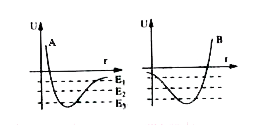Potential energy U (for a pair of atoms) versus interatomic separation r for two substance A and B are as shown.

For both substance, graphs of U v/s t are on same scale :
Where E1,E2andE3 are total energy line (for a pair of atoms) and T1,T2andT3 are the corresponding temperatures. Also T1>T2>T3.
Column-IColumn-IIA) Expands of heatingP) Substance AB) Contracts on heatingQ) Substance BC) Liquifies above temperatureT1D) Liquifies above temperatureT2
The correct Answer is:A-P; B-Q; C-P,Q; D-P
Topper's Solved these Questions
- BOOK - AAKASH SERIESCHAPTER - THERMAL PROPERTIES OF MATTEREXERCISE - EXPANSION OF LIQUIDS (LECTURE SHEET) Integer Type Questions5videos
THERMAL PROPERTIES OF MATTER
- BOOK - AAKASH SERIESCHAPTER - THERMAL PROPERTIES OF MATTEREXERCISE - EXPANSION OF LIQUIDS (PRACTICE SHEET) LEVEL-I (Straight Objective Type Questions)15videos
THERMAL PROPERTIES OF MATTER
- BOOK - AAKASH SERIESCHAPTER - THERMAL PROPERTIES OF MATTEREXERCISE - EXPANSION OF LIQUIDS (LECTURE SHEET) Linked Comprehension Type Questions6videos
THERMAL PROPERTIES OF MATTER
- BOOK - AAKASH SERIESCHAPTER - SYSTEM OF PARTICLES AND ROTATIONAL MOTIONEXERCISE - PRACTICE EXERCISE99videos
SYSTEM OF PARTICLES AND ROTATIONAL MOTION
- BOOK - AAKASH SERIESCHAPTER - THERMODYNAMICSEXERCISE - EXERCISE - 333videos
THERMODYNAMICS
Similar Questions
Knowledge Check
- Question 1 - Select One
In following isothermal graphs A, B and C at temperatures T1,T2 and T3, the correct order of temperatures will be :
 AT1>T2>T3BT1>T3>T2CT3>T2>T1DT3>T2>T2
AT1>T2>T3BT1>T3>T2CT3>T2>T1DT3>T2>T2 - Question 2 - Select One
Activation energy (Ea) and rate constants (k1 and k2) of a chemical reaction at two different temperatures (T1 and T2) are related by
Aln K2K1=−EaR(1T1−1T2)Bln K2K1=EaR(1T1−1T2)Cln K2K1=−EaR(1T1+2T1)Dln K2K1=−EaR(1T2−1T1) - Question 3 - Select One or More
Activation energy (Ea) and rate constants (k1 and k2) of a chemical reaction at two different temperatures (T1 and T2) are related by
Alnk2k1=−E□R(1T1−1T2)Blnk2k1=−EaR(1T2−1T1)Clnk2k1=EaR(1T2+1T1)Dlnk2k1=EaR(1T1−1T2)
A black body radiates heat at temperatures T1 and T2(T2>T1 the frequency corresponding to maxium energy is
View SolutionActivation energy (Ea) and rate constants (k1 and k2) of a chemical reaction at two different temperatures (T1 and T2) are related by
View SolutionActivation energy (Ea) and rate constant (K1 and (K2) for a chemical reaction at two different temperatures T1 and T2 are related by:
View SolutionActivation energy (Ea) and rate constant (k1andk2) of chemical reaction at two different temperatures (T1andT2) are related by :
View SolutionAssertion : Current versus potential difference (i-V) graph for a conductor at two different temperatures T1 and T2 is shown in figure. Hence T1>T2.

Reason : Resistance of a conductor increases with rise in temperature.View Solution

